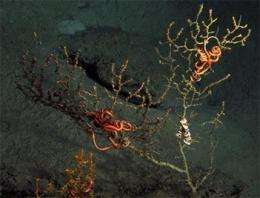Scientists find damage to coral near BP well

For the first time, federal scientists have found damage to deep sea coral and other marine life on the ocean floor several miles from the blown-out BP well - a strong indication that damage from the spill could be significantly greater than officials had previously acknowledged.
Tests are needed to verify that the coral died from oil that spewed into the Gulf of Mexico after the Deepwater Horizon rig explosion, but the chief scientist who led the government-funded expedition said Friday he was convinced it was related.
"What we have at this point is the smoking gun," said Charles Fisher, a biologist with Penn State University who led the expedition aboard the Ronald Brown, a National Oceanic and Atmospheric Administration research vessel.
"There is an abundance of circumstantial data that suggests that what happened is related to the recent oil spill," Fisher said.
For the government, the findings were a departure from earlier statements. Until now, federal teams have painted relatively rosy pictures about the spill's effect on the sea and its ecosystem, saying they had not found any damage on the ocean floor.
In early August, a federal report said that nearly 70 percent of the 170 million gallons of oil that gushed from the well into the sea had dissolved naturally, or was burned, skimmed, dispersed or captured, with almost nothing left to see - at least on top of the water. The report was blasted by scientists.
Most of the Gulf's bottom is muddy, but coral colonies that pop up every once in a while are vital oases for marine life in the chilly ocean depths.
Coral is essential to the Gulf because it provides a habitat for fish and other organisms such as snails and crabs, making any large-scale death of coral a problem for many species. It might need years, or even decades, to grow back.
"It's cold on the bottom, and things don't grow as quickly," said Paul Montagna, a marine scientist at the Harte Research Institute for Gulf of Mexico Studies at Texas A&M University in Corpus Christi. He was not on the expedition.
Montagna said the affected area is so large, and scientists' ability to explore it with underwater robots so limited that "we'll never be able to see everything that happened down there."
Using a robot called Jason II, researchers found the dead coral in an area measuring up to 130 feet by 50 feet, about 4,600 feet under the surface.
"These kinds of coral are normally beautiful, brightly colored," Fisher said. "What you saw was a field of brown corals with exposed skeleton - white, brittle stars tightly wound around the skeleton, not waving their arms like they usually do."
Fisher described the soft and hard coral they found seven miles southwest of the well as an underwater graveyard. He said oil probably passed over the coral and killed it.
The coral has "been dying for months," he said. "What we are looking at is a combination of dead gooey tissues and sediment. Gunk is a good word for what it is."
Eric Cordes, a Temple University marine scientist on the expedition, said his colleagues have identified about 25 other sites in the vicinity of the well where similar damage may have occurred. An expedition is planned for next month to explore those sites.
When coral is threatened, its first reaction is to release large amounts of mucus, "and anything drifting by in the water column would get bound up in this mucus," Cordes said. "And that is what this (brown) substance would be: A variety of things bound up in the mucus."
About 90 percent of the large coral was damaged, Fisher said.
The expedition was funded by the Bureau of Ocean Energy Management and the National Oceanic and Atmospheric Administration. The mission was part of a four-year study of the Gulf's depths, but it was expanded this year to look at oil spill damage.
In a statement released Thursday night, NOAA Administrator Jane Lubchenco said the expedition underscored that the damage to marine life from the oil spill is "not easily seen." She added that more research was needed to gain a "comprehensive understanding of impacts to the Gulf."
"Given the toxic nature of oil, and the unprecedented amount of oil spilled, it would be surprising if we did not find damage," she said.
NOAA did not provide any officials or scientists of its own who went on the expedition. The Bureau of Ocean Energy Management said its researcher on the expedition was unavailable.
Cordes said that the expedition did not find dramatic visual evidence of coral damage in other sites north of the well. But he said it was premature to say coral elsewhere in the Gulf was not damaged.
The new findings, though, could mean long-term trouble for the coral southwest of the well, where computer models and research cruises mapped much of the deepwater oil.
Referring to one type of coral known as "gorgonians," Cordes said he had never seen them "come back from having lost so much tissue. It would have to be re-colonization from scratch."
More information:
Photos of the dead coral: http://www.science.psu.edu/alert/photos/research-photos/biology/fisher-photos/
More about the NOAA expedition: http://oceanexplorer.noaa.gov/explorations/10lophelia/welcome.html
©2010 The Associated Press. All rights reserved. This material may not be published, broadcast, rewritten or redistributed.




















